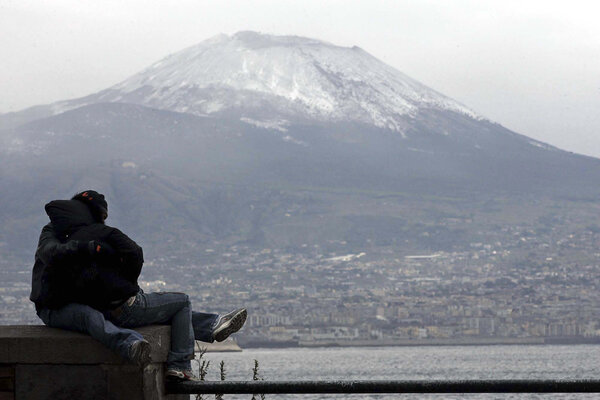After 36,000 years, a massive volcano near Rome rumbles to lifeAn ancient volcano on the outskirts of Rome is showing signs of another enormous eruption – some time in the next 1,000 years or so, say scientists.Christian Science Monitor
By Christina Beck, Staff July 16, 2016
 A couple cuddles in front of the snow-covered Vesuvius volcano in Naples, central Italy, in 2005. Tano Pecoraro/AP/File
A couple cuddles in front of the snow-covered Vesuvius volcano in Naples, central Italy, in 2005. Tano Pecoraro/AP/FileItaly, home to one of the most famous volcanic disasters in history, is showing signs that another massive eruption is brewing, according to a new study published in the journal Geophysical Research Letters.
Almost 2,000 years after the burial of Pompeii and nearby Herculaneum during the eruption of Mt. Vesuvius in 79 A.D., an ancient volcano near Rome is rumbling to life, say scientists. About 19 miles away from the heart of Rome, an ancient volcanic district called the Colli Albani is stirring. The Colli Albani, a 9-mile-long semicircle of hills on the outskirts of Rome, last erupted 36,000 years ago, so geologists had classified it as extinct – until about 20 years ago.
In the early 1990s, the area around the Colli Albani Volcanic District began showing geological indicators of a future explosion: ground levels shifted, steam vents opened, and earthquakes shook the hills around the site.
Since that time, scientists have used these symptoms, along with satellite data and information about the volcano’s previous eruptions, to evaluate the risk that the Colli Albani poses to the surrounding region.
The increase in earthquakes (many of which occurred during an “earthquake swarm” between 1991 and 1995) and ground level changes in the region indicate the presence of a magma bubble forming beneath the earth near Colli Albani, pushing upwards until it can erupt.
Using historical data, researchers determined that Colli Albani is not extinct, as was long believed – it merely operates on a 31,000-year cycle of dormancy and wakefulness. And when the volcano is awake, scientists say, it is dangerous.
Over the last 200,000 years, scientists say that the region surrounding the Colli Albani has risen by 164 feet, and it continues to rise by nearly an inch per year, indicating that the magma bubble is still growing. For thousands of years, the magma bubble has been trapped by pieces of land that have now begun sliding against each other. If those pieces shift enough, Colli Albani will erupt.
When conditions are right (or, from a human perspective, terribly, terribly wrong), Colli Albani can produce eruptions similar to the one that destroyed Pompeii and Herculaneum in 79 AD. Like Vesuvius, Colli Albani could erupt with a towering cloud of burning ash and showers of heated "lava bombs" that could damage or destroy nearby towns.
Past eruptions have also seen swift streams of lava, scientists say, where Roman suburbs now cluster. A future eruption could devastate them.
Rome itself would be safe from such an eruption in all but the very worst of circumstances. If the wind is blowing in the right direction, it could steer an ash cloud from Colli Albani towards the heart of the city.
The good news, according to researchers, is that time is on Rome’s side. The study’s lead author, Fabrizio Marra, a volcanologist at the National Institute of Geophysics and Volcanology in Rome, told the American Geological Union that he does not expect the Colli Albani to erupt for another 1,000 years.
“We expect for sure some initial stages which may not be so explosive," said Dr. Marra, "but it may evolve in time.”
In the meantime, Roman officials are carefully monitoring the geophysical conditions around the volcano, to keep area residents safe.
http://www.csmonitor.com/Science/2016/0716/After-36-000-years-a-massive-volcano-near-Rome-rumbles-to-life
![]() 6 new categories and 72 new items added to the shop!
6 new categories and 72 new items added to the shop!![]() 6 new categories and 72 new items added to the shop!
6 new categories and 72 new items added to the shop!